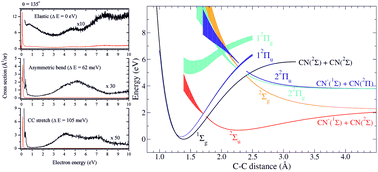Resonant states in cyanogen NCCN†
Abstract
In a combined experimental and theoretical study we probe the transient anion states (resonances) in cyanogen. Experimentally, we utilize electron energy loss spectroscopy which reveals the resonance positions by monitoring the excitation functions for vibrationally inelastic electron scattering. Four resonances are visible in the spectra, centered around 0.36 eV, 4.1, 5.3 and 7.3 eV. Theoretically, we explore the resonant states by using the regularized analytical continuation method. A very good agreement with the experiment is obtained for low-lying resonances, however, the computational method becomes unstable for higher-lying states. The lowest shape resonance (2Πu) is independently explored by the complex adsorbing potential method. In the experiment, this resonance is manifested by a pronounced boomerang structure. We show that the naive picture of viewing NCCN as a pseudodihalogen and focusing only on the CC stretch is invalid.



 Please wait while we load your content...
Please wait while we load your content...